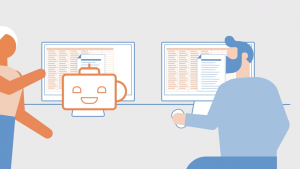Robotic process automation (RPA) is now a standard at many federal agencies, but experts across the board urge interested parties to introduce bots to systems and employees the right way.
In many ways, RPA is simple; bots operate as users on systems, and they save employees time, while accomplishing agency requirements. The end result is a happier, more productive workforce and a more cost-effective and efficient agency. But that’s not the end of the story.
RPA is not some magical elixir for agencies that achieves the right sum no matter the inputs. In fact, if an RPA bot is given wrong or poorly managed inputs, the end result can be clogged and you can end up with inconsistent data.
 Therefore, agencies still need to prioritize that the systems and pipelines are in place to make RPA implementations a success. And data quality is most important.
Therefore, agencies still need to prioritize that the systems and pipelines are in place to make RPA implementations a success. And data quality is most important.
To maximize the usefulness of RPA bots, consider the following best practices:
- Standardize the format for inputs as much as possible.
- Lay out clear instructions for bots if there are different types of inputs.
- Regularly evaluate instructions for bots and compare them to output to see if there are gaps in the process or code that need to be addressed.
- Regularly assess process or code by comparing bot instructions to output.
Consistent evaluations will ensure that the process is transparent. If reports are incorrect, decisions could be based on flawed data. But as long as developers collaborate with people close to the processes that RPA will touch, bots and humans can work side by side in harmony.

This brings up one of the most important parts of successful RPA implementations: the people component. RPA bots are not taking employees’ jobs. It’s important that leaders explain that bots are removing repetitive and rote processing and freeing up employees to do more high value work.
Here’s a model that agencies should follow in implementing RPA:
- Be strong in advocating for RPA.
- Encourage employees to weigh in on the repetitive and unnecessary parts of their jobs.
- Look for the highest-return areas for RPA implementations.
- Dispel myths about RPA.
- Connect developers and users to ensure that instructions are clear and effective.
Agencies should prepare employees for what to expect with RPA. Bots have no physical presence, since they’re software. But on-screen, they look just like human employees – typing in values while scanning with a cursor – and they even have their own security keys and credentials. Therefore, communication is a vital part of any successful RPA implementation.
This blog post is an excerpt from our new self-paced course, Implementing Automation to Eliminate Manual and Repetitive Work, register for free here to learn why cutting-edge governments have embraced RPA, and how it allows users to be more productive.






Leave a Reply
You must be logged in to post a comment.